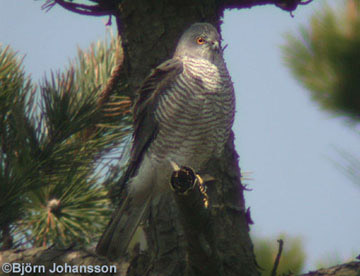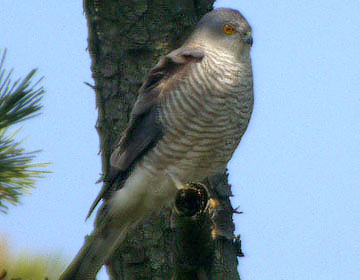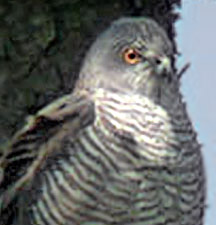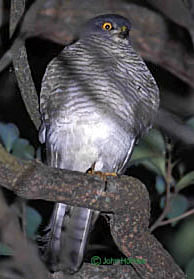An atypical female Japanese Sparrowhawk or Korea’s first Shikra?
Nial Moores, June 9, 2003
With the understanding that small accipiters can be amongst the more often misidentified species, as they are known to show considerable individual variation, compounded by obvious sexual dimorphism and age differences, this note aims to elicit information from birders around the region on diagnostic differences (if any) that exist between immature and/or female-type Japanese Sparrowhawk Accipiter gularis and Shikra Accipiter badius.
It was written in response to a puzzling and (perhaps) as yet unidentified accipiter seen on the migrant hotspot of Eocheong Island, southwest South Korea, on May 2nd 2003. Although considered probably to be gularis, primarily on range, it showed several features strongly suggestive of badius - which would be a first and rather unexpected record for Korea. The four accompanying digiscope images were taken by NM, Bjorn Johansson (BJ), and Bo Petersson (BP): although BJ’s image is clearer, it is slightly underexposed (- 0.3), and appears significantly darker than the bird appeared in the field.

In very bright conditions on May 2, 2003, NM, BJ, and BP, were on Eocheong island (off the west coast of South Korea), when a Dusky Thrush Turdus naumanni flew into a dense area of conifers, being chased by a rather solid-looking accipiter. The accipiter gave up the chase, and landed, largely hidden in shade, in a pine tree about 40 m from us, where it stayed for about 1 minute - time enough for all three of us to digi-scope it. It then flew away low, giving only a brief view of the underside of the wings.
Overall, the bird looked rather bulky (noted as "big" by all three observers) and very pale grey on the head. It lacked an obvious supercilium (showing diffuse white only across the supralorals), and it showed a weak mesial stripe. In flight, the tail looked fairly long, and the very brief view of the underside of the wing revealed dusky tips to the primaries (an impression shown perhaps by a very few Accipiter gularis), and fairly pale, but barred underwings
After the bird had disappeared, and despite the fairly extensive experience of accipiters in Far East Asia of all three observers, there was a shared (and perhaps rather puzzled) silence: what age and sex was this bird? Moreover, Nial Moores asked, what species was it?
Although considered by all three observers at the time to have been most probably a female Japanese Sparrowhawk Accipiter gularis (on e.g. range, and the combination of a weak mesial stripe and strong underparts barring), a number of features looked exceptional to Nial Moores for gularis. Indeed, in many respects, and based on limited personal experience, Nial Moores considered it appeared at least as close in appearance to the extralimital Shikra A. badius. This impression was further reinforced by subsequent internet searches, a review of available literature (including several Japanese photographic guides, Robson’s South-east Asia guide, and Inskipp and Inskipp’s et al. guide to the Indian subcontinent), subsequent discussion between Nial Moores and BJ, and by a review of this note most especially by Bill Harvey and Nikhil Devasar in India.

The four (rather similar) images in this note reveal most of the structural and plumage details well. The bird was rather powerful, with a broad chest, large head (with an obviously domed crown and relatively small eyes), powerful legs, and a fairly long and heavy tail. In these respects, of the three small to medium-sized "sparrowhawks" recorded in Korea (Japanese A. gularis, Northern A. nisus and Chinese Sparrowhawk A. soloensis) it matched nisus most closely. However, it showed a weak mesial stripe that, along with several other plumage details (including the very poor "supercilium"), effectively ruled out that taxon. The clarity of the barring on the underparts (lacking coarse breast streaking) also ruled out all ages of soloensis, as well as adult male and obviously immature gularis. The only choice remaining out of the three species and age/sex groups, therefore, was that of female gularis, adult or near-adult.
Structurally, however, the bird looked to Nial Moores (based on experience of many hundred gularis in Korea and Japan since 1990) atypically large and strong - even for a large female. Typical gularis (in the region) look weak-chested, with flattish heads and rather large, prominent eyes (set off by a bright yellow eye-ring, and a prominent brow, sometimes delineated by a weak supercilium), and comparatively short tails. Typical female (and immature) gularisalso look rather dark overall, especially on the crown and down onto the ear coverts, while this bird was strikingly soft blue-grey on the head-sides (largely in shade in the images) - matching soloensis and badius - with a brown wash weakly on the crown and much more strongly over that part of the upperwing which was visible, and a warmer wash extending from the neck sides back towards the nape. While the clarity of the barring on the underparts appeared typical of female gularis (coarser and with wider spaces between the bars than seen in images of badius subsequently found on the internet) the tone of the barring was rather more rufous than the expected cold grey-brown of most females, and unusually it did not extend obviously onto the "thighs", or the undertail coverts, which instead appeared largely clean white with only isolated marks.
As suggested by BP some of the apparent plumage anomalies could simply be age-related features: nisus females can develop some male-type characteristics, so perhaps can gularis, suggesting that the greyness of the headsides, and the rufous tones of the underparts’ barring could simply be features of an older adult female. However, even male gularis tend to look very dark on the crown and ear coverts, appearing dark-capped, while this bird appeared much paler on the ear coverts, and with warmer neck sides.
Can some older female gularis indeed appear paler on the head sides than younger females?
How variable is the coloration of the ear coverts?
Although the structure and plumage features were considered by Nial Moores (and BJ) to be atypical of gularis, do the same features also rule out or instead better match badius?

Measurements given in Robson (2000) clearly indicate that badius is larger than gularis (with length given as 30-36 cm and 25-31 respectively), while personal observations suggest it is rather bulkier, with a more domed head shape, and wingtips falling rather shorter on the longer tail.
Both ND and BH state from their regular experience in India that the structure of the Eocheong bird matches badius. In addition, although depicted in Robson (2000) as being very pale grey across most of the upperparts, with much finer rufous barring below, both ND and BH also state that female badius often show a variable brown wash on the upperparts with grayer ear coverts/head sides, matching the plumage of this bird. Robson (2000) himself too states that female badius have: "upperside washed brownish (particularly nape and mantle), underparts are coarsely barred rufous".
Images on the internet suggest that badius can show a warmer wash extending back from the neck sides (part of the brown wash described by Robson?), while the underparts’ barring - probably considered the main plumage feature weighing against identification as badius by Nial Moores - is considered by BH to be within the range of the species, which moreover typically shows contrasting whiter "thighs" and undertail coverts, similar to this individual. Indeed, apart from the subtle differences in spacing of the bars and the whiteness of the "thighs"’ (partly caused by a different posture), the image of a female badius taken by BH in India and posted on the Delhibird site appears rather similar to the Eocheong bird, in strength, tone and extent (at www.delhibird.org/id_feature-2/shikra).

Looking in more detail at the bare parts coloration too, the iris of this individual, clearly shown in the image and noted at the time, was bright orange - also believed by Nial Moores atypical for female-type gularis, but considered by BH to be within the range of adult female badius.
How important might iris-colour be in identifying this individual?
Robson (2000) notes that the eye-colour of juvenile gularis is yellow, and that of females "orange-yellow to yellow", while NM’s personal experience of gularis suggest that the vast majority of (adult) female gularis actually show yellow iris colour. This is in contrast to Jesper Hornskov (JH), who based on experience of gularis in China, considers that "it’s wise to ignore iris colour - it varies with age." (JH in lit.). Perhaps more significantly, the Eocheong bird (noted at the time, and from images) lacked the yellow eye-ring typical of gularis, instead showing a more obvious dark "rim", a feature shared by images of badius on the internet (including all of the images posted on the Delhibird website).
Is this black eye-rim/lack of a yellow eye-ring a significant identification criterion?
According to BH in badius the "eye ring as far as I know is never yellow but black" (BH in lit.). Can gularis, however, also lack an obvious yellow eye-ring? The cere too looked unusual for gularis, especially for an older individual: pale yellow, and flattish, rather than bright yellow or yellow-green, peaked and prominent. Although appearing to match the cere type found in some images of adult badius, this weaker coloration is considered to be rather more typical of younger birds in many raptor species including gularis. As several plumage features suggest that if this individual was gularis it would need to be older than a second calendar year bird, could such an older bird show this combination of weakly colored cere, orange eyes and rufous tones to the barring?
The angle of observation and the resultant images did not allow a clear view of much of the upperside; nor do the images allow a view of the barring on the uppertail - which however, is clearly most obvious in the images on the center of the undertail.
How useful are such features in separating gularis and badius anyway?
BH notes that barring in adult badius "is only on the central feathers and often very difficult to see except in overhead flight", while reference to the Delhibird site, other images on the net, and the descriptions in Robson (2000) suggest that both tail barring and more especially even primary tip to tail tip ratios might well appear rather similar in both taxa at certain ages - though badius is typically perhaps rather longer tailed and shorter-winged. According to BH and ND, the tail barring, the wing length in relation to the tail all fit badius well.
A major point against identification of this accipiter as badius is its range.
Considered by (the rather unreliable) MacKinnon and Phillipps (2000) to be a resident, and by JH to be a very scarce resident even in southern China (not even reliably recorded in Hong Kong), Robson (2000) nonetheless notes that badius is subject to local movements, uncommonly wintering southward, and even occurring as a vagrant as far south as Singapore.
Although vagrancy northward to South Korea might appear highly unlikely, there are several other "resident" southern species that have unexpectedly crossed the Yellow Sea in spring, including Crested Serpent Eagle Spilornis cheela, while also recorded on Eocheong Island within one week of this unidentified accipiter were "overshooting" White-shouldered Starling Sturnus sinensis, Ferruginous Flycatcher Muscicapa ferruginea, Black Bittern Dupetor flavicollis and Ashy DrongoDicrurus leucophaeus.
Could it be that the lack of observers across much of eastern China and the obvious confusion potential with gularis might mean that the occasional northward-moving badius would simply be overlooked?
Without diagnostic identification criteria, could there even be a significant gap in our understanding of the distribution of these very similar taxa?
In conclusion: although still considered confidently by BP to be an adult female gularis, and thought very much more likely to be gularis by JH, this individual was, on the basis of the images and description, also confidently identified as an adult female Shikra Accipiter badius by those with great experience of the species in India (JH and ND in lit.).
Aware of the significance of such an identification, however, Nial Moores and Bjorn Johanssonstill consider that there is a continuing need to gather further information on the two taxa, in order both to establish diagnostic identification criteria, and if possible, ultimately to identify this reasonably well-observed and photographed individual…an atypical female Accipiter gularis or perhaps Korea’s very first Shikra.
With thanks to Jesper Hornskov, Bill Harvey and Nikhil Devasar for providing comments on the original draft, and with thanks in advance for all and any further comments.
Main References:
- MacKinnon, J. & K. Phillipps. (2000). A Field Guide to the Birds of China. Oxford University Press.
- Robson, C. (2000). A Field Guide To The Birds of South-east Asia.New Holland Publication.
Discussion:
• Jesper Hornskov wrote (June 06, 2003):
"I wouldn’t have a problem with that Accipiter as Japanese Sparrowhawk… I only see one (Shikra) every 3-4 years in Yunnan - it seems to be a very scarce bird in China…
It would need to be a female (Japanese) probably older than 2nd cal-y. The upperwing looks too dark for Shikra, and the underparts barring too bold, extending onto the tarsus feathering (contra illustration of Shikra in India guide)…. Mostly it’s wise to ignore iris colour - it varies with age…Shikra is a resident occurring no nearer than (?) - not listed even as a Category E bird for Hong Kong."
• Bill Harvey wrote (June 06, 2003):
It is a Shikra based on "wing-length, coloration and I believe the belly is whitish (and thus the thighs). I haven’t seen Japanese for years and never perched but shouldn’t it be darker, have longer wings and have strongly barred belly and thighs? If its a Shikra its an adult, almost certainly female. See our bird of the month on www.delhibird.org.
• Nial Moores replied to BH with the following series of questions:
Shikra females can show orange eyes (presumably older females?)
Shikra females can show very grey ear coverts while still showing a strong brown wash on the upperwing?
Shikra can show such coarse barring? This bird is within the range of Shikra?
The structure looks unremarkable for Shikra?
Adult Shikra show only dusky tips to the primaries, not solidly black? and lastly,
Shikra do not show an obvious yellow eye-ring?
• Bill Harvey replied (June 6):
Re eye colour. Yes can be quite deep orange yellow (as male can be quite deep red!).
Re ear coverts. Yes usually grey.
- Re barring Yes, in females can be quite obvious.
Re Structure. Your bird fits, esp wing length and head shape. Re wing tips. Always dusky never solid black.
Re eye ring. As far as I know is never yellow but black (see our pics).
I forgot to mention the tail barring which in adult Shikra is only on the central feathers and often very difficult to see except in overhead flight. Also having looked at your second pic you can see quite clearly the thighs are unbarred white and the lower belly only slightly so. I have no doubt thats what your bird is, an adult female Shikra. I see at least one daily and had one calling in the garden an hour ago!"
Bill Harvey, New Delhi, India
bill@delhibird.org
• Nikhil Devasar (June 06, 2003) also wrote:
"I would say it is a female Shikra based on limited tail barring, wing length and pale coloration. The thighs are buried in the belly feathers but could well be unbarred."
nik@delhibird.org,
http://www.delhibird.org/
• Nial Moores asked: "Do female badius show an extensive brown wash on the upperparts?
• Nikhil Devasar replied: "Yes they often do but its variable."
• Phil Round (June 10 2003):
"I think the Accipiter is an aberrant Japanese Sparrowhawk. Although I have less detailed experience of that species than many of the others with whom you will have been in contact, the ventral barring on your bird does not seem to be as strongly rufous-tinged, nor does it seem as coarse, as I would expect that on a female Shikra to be."
Dr Philip Round, Bangkok, Thailand.
• John Holmes (June 12 2003):

"We get Japanese Sparrowhawk as a passage migrant here in HK. This one was photographed in October last year. I believe it is a female. The males, obviously, are very small, and this wasn’t...
For what it’s worth I think your bird is the same species."
John Holmes, Hong Kong.
• Krys Kazmierczak (June 12 2003):
"I can’t say that I’m all that experienced with Japanese Sparrowhawk, but what struck me was that you report all 3 observers as having the impression of a big accipiter.
Japanese Sparrowhawk is basically a rather small accipiter, whereas a female Shikra makes quite a sizeable impression. If I saw this bird in the field in India, I don’t think I would really think very hard before identifying it as a female Shikra. The structure and bulk seem right. The underpart barring is within range. The iris colour is definitely normal. The dark reddish rim to the eye is I think typical. Cere, like everything else, is variable in this species. Brown wash to upperparts is typical in the female. Mesial stripe is often faint. I don’t think undertail pattern is of much help on perched birds.
I would plump for Shikra."
Krys Kazmierczak, Oriental Birding.
• Rishad Naoroji (June 16 2003):
"I have looked carefully at the mystery Accipiter in the e-mail that you sent and compared it with the few photos of Japanese Sparrowhawk (A.gularis). I do not think that it is a Shikra based on the following:
the barring of the underparts is too evenly and openly spaced,
barring not rufous enough for Shikra.
Shikra typically have more closely spaced and distinctly narrow rufous barring. In addition, the barring of the upper breast tends to more closely spaced, often merging to produce an almost solidly coloured area, whereas the spacing gradually becomes more widely spaced on the lower underparts. Female Shikra are typically more coarsely barred on the underparts than are males.
After reviewing the few photographs that I have of Accipiter gularis, I am strongly inclined to think that the mystery Accipiter is also an A.gularis. The bird in the image shows particularly even, well formed brown barring with a rufous tint that is not dramatically different from some of the images of A.gularis in my collection. As regards other traits, I cannot see them well enough, or they are similar enough between species as to be of little use as a tool to seperate them. One trait visible that does trouble me is the lack of a prominent eye-ring on the mystery bird. All the images of A.gularis that I examined showed a distinct green eye-ring. Otherwise, the appearance of the head markings and color are consistant with A.gularis adult females."
Rishad Naoroji.



